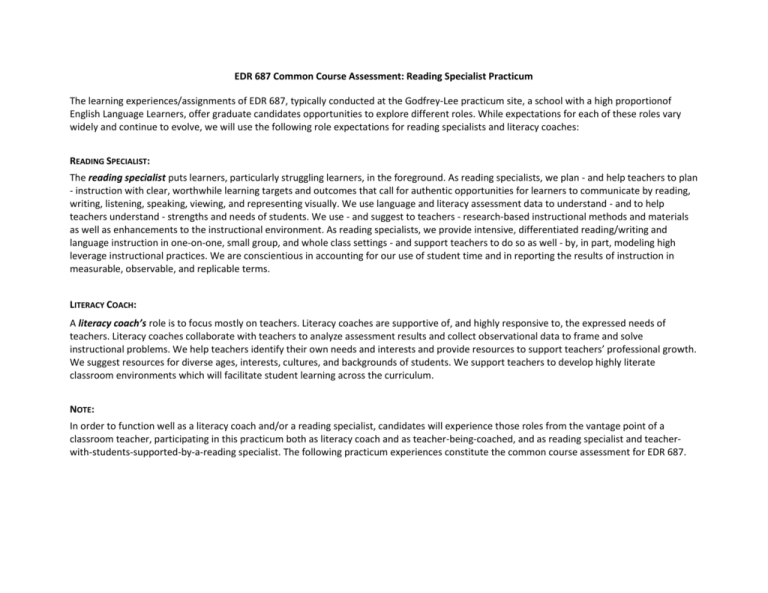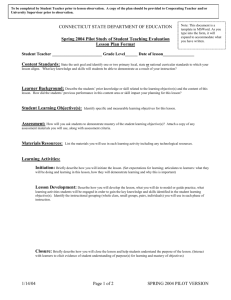Common Course Assessment
advertisement

EDR 687 Common Course Assessment: Reading Specialist Practicum The learning experiences/assignments of EDR 687, typically conducted at the Godfrey-Lee practicum site, a school with a high proportionof English Language Learners, offer graduate candidates opportunities to explore different roles. While expectations for each of these roles vary widely and continue to evolve, we will use the following role expectations for reading specialists and literacy coaches: READING SPECIALIST: The reading specialist puts learners, particularly struggling learners, in the foreground. As reading specialists, we plan - and help teachers to plan - instruction with clear, worthwhile learning targets and outcomes that call for authentic opportunities for learners to communicate by reading, writing, listening, speaking, viewing, and representing visually. We use language and literacy assessment data to understand - and to help teachers understand - strengths and needs of students. We use - and suggest to teachers - research-based instructional methods and materials as well as enhancements to the instructional environment. As reading specialists, we provide intensive, differentiated reading/writing and language instruction in one-on-one, small group, and whole class settings - and support teachers to do so as well - by, in part, modeling high leverage instructional practices. We are conscientious in accounting for our use of student time and in reporting the results of instruction in measurable, observable, and replicable terms. LITERACY COACH: A literacy coach’s role is to focus mostly on teachers. Literacy coaches are supportive of, and highly responsive to, the expressed needs of teachers. Literacy coaches collaborate with teachers to analyze assessment results and collect observational data to frame and solve instructional problems. We help teachers identify their own needs and interests and provide resources to support teachers’ professional growth. We suggest resources for diverse ages, interests, cultures, and backgrounds of students. We support teachers to develop highly literate classroom environments which will facilitate student learning across the curriculum. NOTE: In order to function well as a literacy coach and/or a reading specialist, candidates will experience those roles from the vantage point of a classroom teacher, participating in this practicum both as literacy coach and as teacher-being-coached, and as reading specialist and teacherwith-students-supported-by-a-reading specialist. The following practicum experiences constitute the common course assessment for EDR 687. PRACTICUM EXPERIENCES 1. PLAN INSTRUCTION Use principles of ‘Understanding by Design’ (Wiggins & McTighe, 2005) and ‘Problem-based Learning’ (http://www.bie.org/) as well as current standards (http://www.corestandards.org/) to guide teaching teams to construct an inquiry unit that provides students with authentic opportunities to learn concepts of high interest or relevance, by reading, writing, speaking, listening, viewing, and representing visually, mindful of needs of English language learners. Use literature on English Language Learners and literacy instruction to guide teaching teams to make a calendar that integrates inquiry unit and shows learning experiences students will engage in; include rationale for choices. Experiences should address themes of Literacy Program: build communities of inquiring readers, write to share important ideas, and develop rich language in context of inquiry. Develop detailed plan for each lesson to be modeled for peers and/or observed by instructor (at least two per week). These practicum experiences address IRA standards 1.1, 2.1, 2.2, 2.3. 2. CONDUCT ASSESSMENT Lead teaching team in design of initial formative assessment(s) of reading, writing, and language skills that are learning targets/instructional goals of inquiry unit. Formative assessment gathers evidence of student learning re: specific instructional goals; evidence guides teacher and student decisions about what to do to improve teaching and learning (Valencia, unpublished manuscript). Provide actual assessment with rationale and plan for administration and analysis. Conduct, with teaching team members, initial assessments. Videorecord. Collaborate with teaching team members to analyze assessment data. Refine instructional objectives and develop indicators of success for each student. Repeat formative assessment at least two more times, documenting response to instruction and revising instructional objectives, indicators of success, and/or instructional approach. Each member of teaching team will take primary responsibility for documenting the learning of an equal proportion of students. Save daily, organize and maintain in folder in classroom artifacts or recordings of student reading, writing, and speaking with anecdotal notes. Prepare, with student, a display of artifacts of student learning to be presented to families during an ‘open house.’ Each member of teaching team will prepare letters to families and referring teachers that describes ‘their’ students’ instructional experiences with evidence of learning in response to instruction. These practicum experiences address IRA standards 3.2, 3.3, 3.4. 3. PROVIDE INSTRUCTION Provide instruction to whole class, small groups, and/or individuals consistent with instructional objectives established by teaching team using assessment data. Provide support in the context of classroom instructional experiences; ‘pull-out’ type instruction is discouraged unless justified. Incorporate themes: building communities of inquiring readers, writing to share important ideas, and developing rich language in the context of inquiry. Demonstrate the use of research-based instructional practices that are appropriate, equitable, and differentiated for diverse learners, mindful of students’ interest, developmental levels, linguistic, and cultural characteristics. Provide an instructional environment with multiple texts/ways to access ideas, participation structures and routines as well as low-risk social environment that include choice and sufficient scaffolding to facilitate success in meeting instructional objectives. Participate in self- and peer-evaluation of instruction in the context of classroom learning labs. Each candidate will serve as host for one learning lab; guest, for several other labs. Participate in self- and instructor-evaluation in conferences with instructor using video of instruction and analysis of that video. Each candidate will engage in one coaching session around plans for lesson and one instructional conference per week. These practicum experiences address IRA standards 4.1, 4.2, 5.1. 4. FACILITATE REFLECTION ON INSTRUCTION Engage in the study of literacy coaching practices via study of course text (Toll) and professional literature (self-selected and recommended) in advance of teaching. During teaching, participate in weekly professional development with after-school opportunities to engage members of own teaching team in analysis of assessment data and planning, reflecting on instruction and problem solving. Move as needed between roles as facilitator, collaborator, and consultant. These practicum experiences address IRA standards 6.3. Scoring Guide/Rubric for EDR 687 Common Course Assessment: Reading Specialist Practicum The reading specialist/literacy coach candidate will… 1.1 IRA Standard Distinguished (3) Proficient (2) Progressing (1) Unsatisfactory (0) Analyze quality of learning environment for factors contributing to reading and writing success including individual motivation to read and write. Accurately describe learning environment -and prompt others to describe it - featuring student learning; Accurately describe learning environment; Describe learning environment with limited insight; Does not meet criteria for progressing. Consider in analysis - and prompts others to consider - relations between cognitive, linguistic, motivational, and/or sociocultural factors re: learning of individuals; Apply literature to specific environment; Takes responsibility for creating learning environment that ensures success and prompts others to consider how to do so. 2.1 Design, implement balanced curriculum; work with others to assure suitable, balanced curriculum for all learners Use ‘Understanding by Design’ inquiry model to collaboratively design and implement lessons of a coherent unit of study that integrates a balanced literacy curriculum (see ‘proficient’ criteria) with interesting content. Consider in analysis - and prompt others to consider - individual cognitive, linguistic, motivational, socio-cultural factors re: sub-group (e.g., boys, English language learners) characteristics; Cite useful literature; Assigns responsibility to students for some factors/outcomes that are within teachers’ control, but recognizes this upon discussion. Show in analysis limited awareness of cognitive, linguistic, motivational, and/or socio-cultural factors; Interpret students from deficit perspective; Fail to cite appropriate literature; Assigns responsibility to students for factors that are teachers’ responsibility. Ill-equipped to help others analyze learning environment. Collaboratively design, implement lessons that balance direct instruction, supported and independent work; individual and group work; teaching skills and providing authentic opportunities for oral and written forms of communication. Lessons are designed in a ‘divide and conquer’ approach rather than collaboratively, lack balance or coherence or interest or authentic opportunities to use oral and written communication. Does not meet criteria for progressing. 2.2 IRA Standard Distinguished (3) Proficient (2) Progressing (1) Unsatisfactory (0) Use literature- researchsupported instructional approaches to develop word recognition, comprehension and critical thinking, oral language, and written expression in all learners; support others to do so. Select instructional approaches that suit instructional purpose and teacher need; Select instructional approaches that suit instructional purpose; Instructional approaches are not ideally suited to instructional purpose; Does not meet criteria for progressing. Model for teachers, coteach to hand off; Model for teachers; Provide rationale for choice. Provide feedback if invited to observe or facilitate self-evaluation Rationale has gaps in connections between research and practice. Provide rationale and literature to support choice and implementation. 2.3 Critically evaluate, select, use varied high-quality print, digital, online resources; lead others in collaborative efforts to do so. Select instructional resources that suit instructional purpose, student characteristics and teacher need; Model use, evaluation for teachers, collaboratively select, use, evaluate; Select instructional resources that suit instructional purpose; Model for teachers; Provide rationale for choice. Design, administer, and interpret assessments of reading, writing, language, interest. Leads teachers in the design, administration, and interpretation of assessments of reading, writing, language, interest that are well-matched to students, goals, and instructional context as well as sensitive to Instructional resources are not ideally suited to instructional purpose or student; Does not meet criteria for progressing. Model shows partial understanding of resources; Rationale has gaps in connections between research and practice. Provide rationale and literature to support choice and implementation. 3.2 Model shows partial understanding of approach; Designs, administers, and interprets assessments of reading, writing, language, interest that are appropriate for students, goals, instructional context. Designs, administers, and interprets assessments of reading, writing, language, interest with considerable support required from instructor to align assessments with students, goals, Does not meet criteria for progressing. IRA Standard Distinguished (3) Proficient (2) change. 3.3 3.4 Analyze and use assessment data from multiple sources to plan instruction and monitor response to instruction. Accurately, completely analyzes assessments; Communicate assessment/progress results, implications to educators, families, and learners. Progressing (1) Unsatisfactory (0) instructional context. Uses assessment data to plan instruction, monitor progress in response to instruction and revise instructional goals and approaches as needed. Instructional plans, instructional approaches are not well-informed by initial assessment nor revised in response to progress monitoring data. Does not meet criteria for progressing. Describes substantive learning re: worthwhile goals, with quotes, other evidence from student responses to instruction. Describes progress toward instructional goals, with evidence from student responses to instruction. Does not meet criteria for progressing. Situates learning re: importance of progress. Communication is detailed without jargon. Communication does not describe substantive progress or lacks convincing evidence of progress. Communication is not sufficiently complete or organized. Articulates how instructional goals and plans are aligned with initial assessment data, progress monitoring information. Communication is thorough, accurate, audience-sensitive in content, language. Language or content of message is not suited to the audience. 4.1 Assist teachers to understand the relationship between first and second language acquisition, literacy development. Articulate the relationship between 1st and 2nd language acquisition and literacy, and the implications of this relationship for teaching and learning, supported by relevant literature. Apply this information planning for teaching, coaching. Articulate the relationship between 1st and 2nd language acquisition with citations and literacy and the implications of this relationship for teaching and learning. Description of the relationship between 1st and 2nd language acquisition and literacy is poorly developed and the implications of this relationship for teaching and learning are illdefined. Does not meet criteria for progressing. 4.2 Provide differentiated instruction, use practices, materials that are responsive to, respectful of, learners’ Identifies diversity of language, culture, family background, academic skills and interests present Identifies diversity of language, culture, family background, academic skills and interests Demonstrates limited awareness of individual diversity of language, culture, family Does not meet criteria for progressing. IRA Standard Distinguished (3) Proficient (2) Progressing (1) diverse skills, interests, and backgrounds. in classroom; identifies potential tensions between own backgrounds and those of students and assists teachers to do so. present in classroom; assists others to do so. background, academic skills, interests present in classroom, and of potential tensions between own background and that of students. Guides teachers to use practices, chooses materials that are responsive to, respectful of, learners’ diverse skills, interests, and backgrounds. 5.1 6.3 Create an environment that enables all learners, including English language learners, to use spoken and printed words in multiple instructional opportunities, across a variety of physical settings, with different classroom configurations that are instructionally and socially supportive. Coached discussion of plans, lessons of others show ability to articulate understanding of principles of ‘guided practice’ or ‘gradual release of responsibility’ models of scaffolding student learning. Work with individuals and groups of teachers, observing, modeling, co-teaching, and conducting effective conversations for collaboratively planning and ‘Coaching’ conversations show evidence of thoughtful plan, attention directly focused on student learning, elicits insight, produces deep insights into own and Coaching supports teachers to discover opportunities for more interesting, authentic uses of reading, writing, speaking, listening, viewing, and representing. Uses and models practices, choses materials that are responsive to, respectful of, learners’ diverse skills, interests, and backgrounds. Lesson plan and lessons modeled show use of ‘guided practice’ or ‘gradual release of responsibility’ models of scaffolding student learning. In modeled lessons, students have opportunities for interesting, authentic uses of reading, writing, speaking, listening, viewing, and representing. Leads ‘coaching’ conversations with evidence of using assigned prompts in plan, with attention to student learning, attempts to elicit insights, produces Unsatisfactory (0) Practices, choice of materials are not sufficiently responsive to, respectful of, learners’ diverse skills, interests, and backgrounds. While lesson plan may be based on ‘guided practice’ or ‘gradual release of responsibility’ steps, instructional practice shows limited implementation of such models of scaffolding student learning. Does not meet criteria for progressing. Teacher does most talking; opportunities for interesting, authentic used of literacy are rare. Leads ‘coaching’ conversations with little evidence of planning or attention to authentic student learning and little depth of reflection; Does not meet criteria for progressing. IRA Standard Distinguished (3) Proficient (2) Progressing (1) problem solving. other’s thinking in reflection; insights in reflection; Models instructional practice without an understanding of the practice and without a good fit between practice, learning targets, K-12 student strengths and needs, and teacher needs. Models research-based instructional practices, achieving, articulating fit between practice, learning targets, K-12 student strengths and needs, and teacher needs. Leads co-planning, coteaching efforts with evidence of student and teacher growth. Models research-based instructional practices consistent with learning targets, sensitive to student or teacher needs. Co-plans and co-teaches with shared goals and responsibilities. Co-plans and coteaches by ‘dividing and conquering’ the tasks. Unsatisfactory (0)









